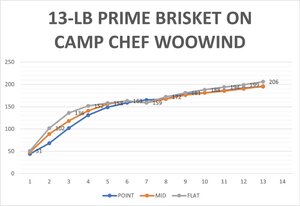1. I've said many times, an overthought brisket is an underdone brisket. An underdone brisket will be dry and tough because the hard-worked collagen in the muscle hasn't melted. Just because if is beef it can't be evaluated like a lazy steak muscle.
Based on the OP's statement above with three probes and a graph, it was cooked to temp not probed for tenderness. (BTW, the fattier point will often probe tender and read at a high temp due to the fat content. Fat melts faster than collagen).
2. Anytime something finishes earlier than expected, it is an indicator. Of what? So many things (probe placement, accuracy, chamber temp, etc). Once I stopped using technology as a path to perfection and returned to the "feel" of probing for tenderness, my results improved dramatically. Internal temp is a guide, never a destination. I probe only the flat for tenderness because the point will lie to you.
3. Rested for 5 hours. Absolutely nothing wrong with that. I rest briskets and butts covered in a 170F oven, often 3-5 hours. I've found better results resting in the heat of an oven rather than a cooler with blankets.
bbbbbbbbbbbbbbbbbbb
1. I've said many times, an overthought brisket is an underdone brisket. An underdone brisket will be dry and tough because the hard-worked collagen in the muscle hasn't melted. Just because if is beef it can't be evaluated like a lazy steak muscle.
Based on the OP's statement above with three probes and a graph, it was cooked to temp not probed for tenderness. (BTW, the fattier point will often probe tender and read at a high temp due to the fat content. Fat melts faster than collagen).
2. Anytime something finishes earlier than expected, it is an indicator. Of what? So many things (probe placement, accuracy, chamber temp, etc). Once I stopped using technology as a path to perfection and returned to the "feel" of probing for tenderness, my results improved dramatically. Internal temp is a guide, never a destination. I probe only the flat for tenderness because the point will lie to you.
3. Rested for 5 hours. Absolutely nothing wrong with that. I rest briskets and butts covered in a 170F oven, often 3-5 hours. I've found better results resting in the heat of an oven rather than a cooler with blankets.
The drier portions make great chili. Been there, done that.
Thanks. All makes sense. I used probes as guides since this was my 2nd brisket. I did probe for tenderness and let the flat fo too long after it probed tender. The mid-section never did probe tender. Anyway, I'll try it again.
The drier portions make great chili. Been there, done that.






